The following are the details of various types numbers. Different types of numbers are used to deal with different situations hence each number type has it own importance.
Natural numbers
- The numbers which are used in counting are called as natural numbers.
- The set of natural numbers is denoted by the letter, N.
Where N= {1, 2, 3, 4…}
- 1 is the smallest natural number.
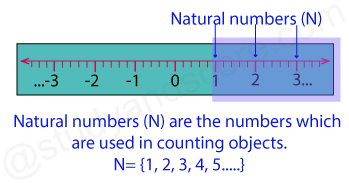
Whole numbers
- When zero is included in the set of natural numbers then they are called as whole numbers.
- The set of whole numbers is denoted by the letter, W.
Where W= {0, 1, 2, 3, 4…}
- All the natural numbers are also whole numbers.
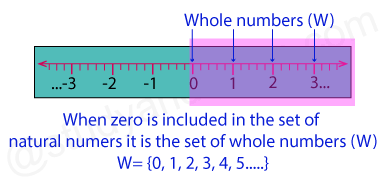
Facts about Whole Numbers
- Number 0 is the first and the smallest of all whole numbers.
- All natural numbers along with zero are called whole numbers.
- Here is no last or greatest whole number since they are infinite.
- All natural numbers are whole numbers. But all whole numbers are not natural numbers. For example 0 is a whole number but not natural number.
- Each whole number is 1 more than its previous number.
Integers
- When the negative numbers of all the natural numbers are included in the set of whole numbers, then they are called as Integers.
- The set of integers is denoted by the letter, Z. The letter Z is taken from the German word zahlen which means to count.
Where Z= {…-4, -3, -2, -1, 0, 1, 2, 3, 4…}
- Zero can never be a positive or negative integer.
- The integers can further be divided into two types,
* Positive integers: All the natural numbers are positive integers.
Example: I+= {1, 2, 3, 4…}
* Negative integers: All the negatives of natural numbers are negative integers.
Example: I- = {-1, -2, -3, -4…}
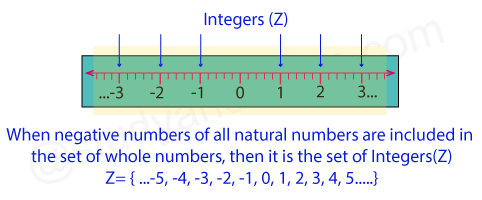
Rational numbers
- The numbers which can be expressed in the form of p/q are called as rational numbers.
Here p and q are integers and q is not equal to 0
- The set of rational numbers are denoted by the letter Q.
Where Q= {1/2, 1/3, 5/6, 7/2, 5, -2, 0…}
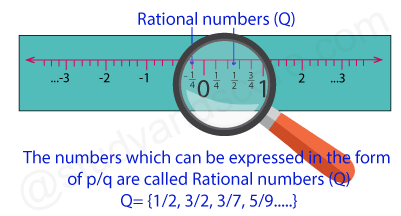
Irrational numbers
- The numbers which CANNOT be expressed in p/q form are called as irrational numbers.
Here also p and q are integers and q is not equal to 0
- The set of irrational numbers are denoted by the letter P.
Where P= {√2, √3, √4, √5…}
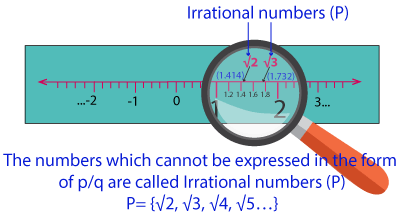
Facts about Irrational Numbers
- The sum of rational and irrational numbers is also an irrational number
(Ex: 3+√2, 6+√4)
- The difference of rational and irrational numbers is also an irrational number
(Ex: 6-√2, 9-√4)
- The product of rational and irrational numbers is also an irrational number
(Ex: 2 x √2, 9 x +√4)
Real numbers
- Real numbers include both rational and irrational numbers. In other words, it includes all the natural numbers, whole numbers and also the integers.
- The real numbers are denoted by the letter R.
- Examples for real numbers are 2, 0, 5, -7, -10, ½, 1/6, 1.14, 1.789…
Even numbers
- The numbers which are divisible by 2 are called as even numbers. They are also the multiples of 2.
- The set of even numbers is denoted by the letter E, Where E= {2, 4, 6, 8, 10…}
- There are infinite even numbers
Odd numbers
- The numbers which are NOT divisible by 2 are called as odd numbers.
- They are NOT multiples of 2.
- The set of odd numbers is denoted by the letter O, Where O= {1, 3, 5, 7, 9…}
- There are infinite odd numbers
Prime numbers
- The numbers which are divisible by 1 and the number itself are called as prime numbers.
- The examples of prime numbers are 2, 3, 5, 7…
Facts about Prime Numbers
- Number 1 is not a prime number.
- Number 2 is the only even prime number.
- There are 25 prime numbers between 1 and 100. Out of these 15 are between 1 and 50 and remaining 10 are between 50 and 100.
Co-prime numbers
- Two natural numbers are called as co-primes if their Highest common factor (HCF) is 1.
- Examples of pairs of co-primes are (7, 9), (15, 16) etc.
- Co-primes are always written in pairs between the brackets.
- It must be noted that the pair of co-prime numbers need not be prime numbers.
Composite numbers
- The numbers which are divided evenly by numbers other than 1 and itself are called as composite numbers.
- For example, 9 can be divided evenly by 3 as well as 1 and 9, so 9 is a composite number. But 7 cannot be divided evenly except by 1 and 7, so is NOT a composite number. So it is a prime number.
- Number 1 cannot be considered as the composite number.
Consecutive numbers
- Consecutive numbers are the series of numbers in which each number is greater than its preceding number by 1.
- For example, 6, 7, 8 or 2, 3, 4 or 11, 12, 13, 14… etc.
- Share with your friends! -





Login to post your comment here...
- or with social Account -